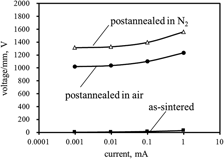Article contents
Nonlinear property of SrCoO3-doped ZnO ceramics sintered in a reducing atmosphere and multilayer ceramic varistors with base metal electrodes
Published online by Cambridge University Press: 13 August 2015
Abstract

This study describes the nonlinear characteristics of SrCoO3-doped ZnO varistors and multilayer ceramic varistors (MLCVs) with copper electrodes, both of which are sintered in a reducing atmosphere. Due to postannealing effects in air or N2 with low-oxygen concentration (0.02%), bulk disks can be sintered in a reducing atmosphere, with a usable V1 mA/mm (e.g., 1600 V for bulk bodies or 1200 V for Cu cofiring) and highly nonlinear indices (α10 μA = V1 mA/V10 μA < 1.3), regardless of whether cofiring with Cu electrodes on disk surfaces was conducted or not. On the basis of this procedure, Cu-MLCVs were successfully produced, without oxidation of Cu-internal electrodes or structural defects. They exhibited high stability as well as a useful nonlinearity of V1 mA = 10.4 V and α10 μA = 1.93. The resultant stability against electrostatic discharge (ESD) satisfies the highest standard of level 4 in IEC61000-4-2 (ESD stability test). This is the first report to show that MLCVs with base metals have practical properties, including stability.
Keywords
- Type
- Articles
- Information
- Copyright
- Copyright © Materials Research Society 2015
References
REFERENCES
- 7
- Cited by


